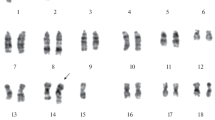Summary
In a tissue culture of male Microtus agrestis, transformation of the originally predominantly diploid cells to a population with 85% triploid cells was observed. The change from diploid to triploid occurred between the 8th and 11th month of tissue culture. Two triploid cell lines could be distinguished and isolated, one with the karyotype 3n,XXY, the other with 3n,XYY. In about 1%, diploid cells with two X or two Y chromosomes were found. Halooid, tetraploid, hexaploid and octoploid mitoses also occurred in a low percentage.
The DNA replication pattern of triploid cells in the S period was studied by means of pulse labeling with 3H-thymidine and by measuring the relative DNA content. The G2 period of triploid cells was found to be about 1 hr longer than that of diploid cells, but about 15 min shorter than that of tetraploid cells. The role of multipolar mitoses in the formation of triploid cells and diploid cells with two X or two Y chromosomes is discussed.
Zusammenfassung
In einer Gewebekultur einer männlichen Erdmaus (Microtus agrestis) wurde die Umwandlung der ursprünglich überwiegend diploiden Zellpopulation in eine Kultur mit 85% triploiden Zellen beobachtet. Die Ploidieänderung trat zwischen dem 8. und 11. Kulturmonat auf. Es konnten zwei triploide Zellinien unterschieden und isoliert werden, eine mit dem Karyotyp 3n,XYY, die andere mit 3n,XYY. Außerdem wurden in dieser Kultur diploide Zellen mit zwei X-oder zwei Y-Chromosomen gefunden, mit einer Häufigkeit von etwa 1%. Ebenso traten haploide, tetraploide, hexaploide und octoploide Mitosen auf.
Durch Kombination von Pulsmarkierung mit 3H-Thymidin und Bestimmung des relativen DNS-Gehalts wurden die DNS-Replikationsmuster triploider Zellen während der S-Periode untersucht. Die mittlere Dauer der G2-Periode triploider Zellen erwies sich als um etwa 1 Std länger als die G2-Periode diploider Zellen, dagegen um 15 min kürzer als bei tetraploiden Zellen. Die Bedeutung multipolarer Mitosen für die Bildung triploider Zellen und diploider Zellen mit 2 X-oder 2 Y-Chromosomen wird diskutiert.
Similar content being viewed by others
References
Beçak, M. L., Beçak, W.: Further studies on polyploid amphibians (Ceratophrydidae). III. Meiotic aspects of the interspecific triploid hybrid: Odontophrynus cultripes (2n=22) x 0. americanus (4n=44). Chromosoma (Berl.) 31, 377–385 (1970)
Comings, D. E.: Quantitative autoradiography of heterochromatin replication in Microtus agrestis. Chromosoma (Berl.) 29, 434–445 (1970)
Mittwoch, U., Delhanty, J. D. A.: Inhibition of mitosis in human triploid cells. Nature (Lond.) New biol. 238, 11–13 (1972)
Pawlowitzki, I. H., Cenani, A.: Sporadic triploid cells in human blood and fibroblast cultures. Humangenetik 5, 65–69 (1967)
Pera, F.: Dauer der DNS-Replikation von Eu-und Heterochromatin bei Microtus agrestis. Chromosoma (Berl.) 25, 21–29 (1968)
Pera, F.: Mechanismen der Polyploidisierung und der somatischen Reduktion. Ergebn. Anat. Entwickl.-Gesch. 43/5, 1–112 (1970)
Pera, F., Rainer, B: Studies of multipolar mitoses in euploid tissue cultures. I. Somatic reduction to exactly haploid and triploid chromosome sets. Chromosoma (Berl.) 42, 71–86 (1973a)
Pera, F., Rainer, B.: Entstehung von Zellen mit weiblichem Chromosomensatz in Gewebekulturen männlicher Erdmäuse 68. Versamml. Anat. Ges. (1973b)
Pera, F., Schwarzacher, H. G.: Die Verteilung der Chromosomen auf die Tochterkerne multipolarer Mitosen in euploiden Gewebekulturen von Microtus agrestis. Chromosoma (Berl.) 26, 337–354 (1969)
Pera, F., Wolf, U.: DNS-Replikation und Morphologie der X-Chromosomen während der Syntheseperiode bei Microtus agrestis. Chromosoma (Berl.) 22, 378–389 (1967)
Schmid, W., Leppert, M. F.: Rates of DNA synthesis in heterochromatic and euchromatic segments of the chromosome complements of two rodents. Cytogenetics 8, 125–135 (1969)
Author information
Authors and Affiliations
Additional information
Supported by the Bundesministerium für Forschung und Technologie of the Federal Republic of Germany.
Rights and permissions
About this article
Cite this article
Pera, F., Scholz, P. Polyploidization in vitro: Formation of a predominantly triploid cell population in an originally diploid tissue culture of Microtus agrestis . Hum Genet 21, 17–26 (1974). https://doi.org/10.1007/BF00278560
Received:
Published:
Issue Date:
DOI: https://doi.org/10.1007/BF00278560




